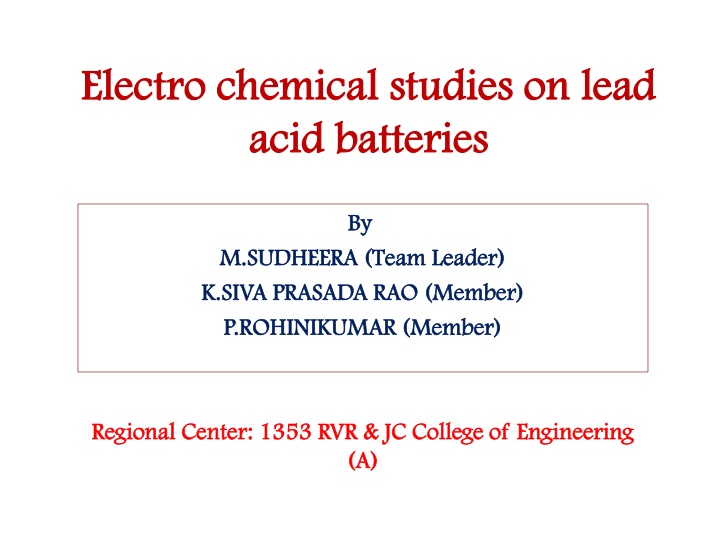
Lead Acid Battery Electrochemical Studies: Tafel Polarization & Corrosion Rate
Explore electrochemical studies on lead acid batteries focusing on Tafel polarization method for corrosion rate determination. Learn about Tafel equation, Tafel graph, estimation of Ecorrand Icorr, and corrosion rate calculation using the corrosion current value Icorr. Discover the significance of the Tafel plot in estimating corrosion resistance.
Download Presentation

Please find below an Image/Link to download the presentation.
The content on the website is provided AS IS for your information and personal use only. It may not be sold, licensed, or shared on other websites without obtaining consent from the author. If you encounter any issues during the download, it is possible that the publisher has removed the file from their server.
You are allowed to download the files provided on this website for personal or commercial use, subject to the condition that they are used lawfully. All files are the property of their respective owners.
The content on the website is provided AS IS for your information and personal use only. It may not be sold, licensed, or shared on other websites without obtaining consent from the author.
E N D
Presentation Transcript
Electro chemical studies on lead Electro chemical studies on lead acid batteries acid batteries By By M.SUDHEERA (Team Leader) M.SUDHEERA (Team Leader) K.SIVA PRASADA RAO (Member) K.SIVA PRASADA RAO (Member) P.ROHINIKUMAR (Member) P.ROHINIKUMAR (Member) Regional Center: 1353 RVR & JC College of Engineering Regional Center: 1353 RVR & JC College of Engineering (A) (A)
Tafel Polarization Tafel extrapolation (TP) method is used for the determination of corrosion rate. TP is one of the major laws used in electrochemistry invented by Tafel, in 1905. 3.3.1 Tafel equation Empirical relation between the over potential of the electrode and the current density passing through the electrode: = a + b log i Where " " is the polarization "a" and "b" are characteristic constants of the electrode system and "i" is the current density.
Tafel Graph : A plot of electrode potential versus the logarithm of current density is called the "Tafel plot" and the resulting straight line the "Tafel line". "b" is the "Tafel slope" that provides information about the mechanism of the reaction, and "a" provides information about the rate constant (and the exchange current density) of the reaction.
The Vertical axis - Represents the potential. The Horizontal axis - Represents the logarithm of absolute current. Straight lines - Represents the Theoretical current for the anodic and cathodic reactions. The curved line is the total current i.e.; the sum of the anodic and cathodic currents. This is the current where sweep potential of the metal is measured with Potentiostat. The sharp point in the curve is actually the point where the current changes signs as the reaction changes from anodic to cathodic, or vice versa.
In most electrochemical corrosion experiments, the first step is the measurement of Eoc. Eoc (Open Circuit Potential) is the equilibrium potential assumed by the metal in the absence of electrical connections to the metal. The value of either the anodic or cathodic current at Eoc is called the Corrosion Current, Icorr. If we could measure Icorr, we could use it to calculate the corrosion rate of the metal. The Icorr valve can be calculated from the E Vs Log I curve which is represented in the figure .
Estimation of corrosion rate Using that corrosion current (Icorr) value we can calculate the corrosion resistance by using the equation which was given as follows. Corrosion rate CR = (Icorrx K x e) / ( x A) Where, Icorr - Corrosion current, A e - Equivalent weight of the corroding material, g K - Conversion constant (3272 for mmpy, 1.288x105 for mpy) - Density of the corroding material, g/cc A - Sample area, Sq.cm.






















